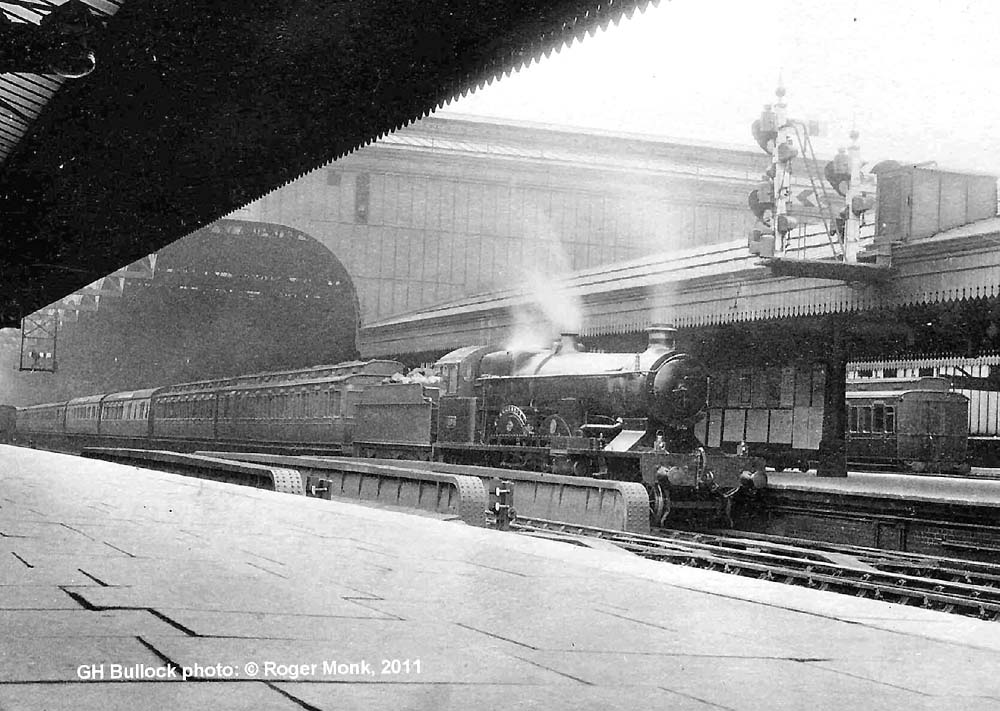 |
|
GWR Route: Banbury to Wolverhampton
GWR Route: North Warwickshire Line
Birmingham Snow Hill Station: gwrbsh1788
 |
Great Western Railway French Compound 4-4-2 No 104 ‘La
Alliance’ waits with a down express at Platform No 5 in the early 1920s.
The girders between the tracks adjacent to the locomotive are those of the
bridge over Great Charles Street. In front of the locomotive below the signals
is the down scissors switch crossing. The first two clerestory coaches behind
the locomotive appear to be strengtheners, added to provide additional
passenger capacity, as they carry no destination headboards on their roof. They
are also in the single colour crimson lake livery, which the Great Western
Railway used between 1912 and 1922. The next coach which is in the familiar
chocolate and cream livery, which was re-introduced in 1922. This is a 57 foot,
toplight, ganged corridor, brake third with; a luggage area, guards compartment
and three third class compartments (diagram D52). Fifteen of these coaches were
constructed in 1912 (lots 1195 and 1203). Two were sold to the war department
for use in ambulance trains, but subsequently repurchased and rebuilt in
1921/22. All of these brake third coaches were condemned in April 1962. In July
1902 the Great Western Railway authorised the purchase of a compound
locomotive, similar to that used in Northern France, for the purpose of trail
and comparison with their new Saint and Star class locomotives. This 4-4-2 De
Glehn locomotive was built by Societe Alsacienne, Belfort and arrived in
Britain in October 1903. It was named No102 ‘La France’.
After a year, two larger De Glehn Atlantics were ordered in
October 1904 under lot 157 and these arrived in June 1905. The tenders were
provided by the Great Western Railway, No 104 being paired with Churchward
3,500 gallon tender No 1642 from lot A66. In 1907 No 104 was named ‘La
Alliance’ to celebrate the signing of the L’Entente Cordiale in that
year. In addition to comparing these locomotives with Swindon built express
locomotives, they were also compared against each other. While No 103 was
retained in the original condition as a control, No 104 was given a fully coned
Churchward Standard No 1 boiler with belpaire firebox (type D4) in August 1907.
This also required outside steam pipes to be fitted and short chimney and
safety valve. The original French belpaire boiler was refitted in June 1909,
but this was replaced again in July 1915, this time with a superheated Standard
No 1 boiler (type D4). With a boiler pressure of 225 lbs the French compounds
had a tractive effort at 85% of 26,935 lbs and were placed in power group B.
The maximum axle weight was 19 tons which restricted them to main lines and a
few branch lines (route availability – Red). No 104 initially worked West
of England and Wolverhampton expresses and from 1913 was based at Oxford shed
(OXF) with Nos 102 and 103, working express and semi fast trains between there
and Paddington or Birmingham. No 104 was eventually withdrawn in September 1928
with a mileage of 778,834.
Robert Ferris
 back back

|
